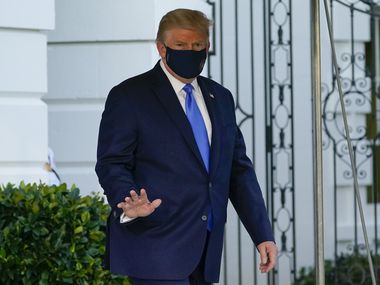Advertisement
Poll Watch
Four years ago, the president easily won Ohio by building a balanced coalition among white voters across educational lines. But his support has waned since then, particularly in the suburbs.

Welcome to Poll Watch, our weekly look at polling data and survey research on the candidates, voters and issues that will shape the 2020 election.
No Republican has ever won a presidential election without taking Ohio, and Donald J. Trump carried it with ease in 2016, performing strongly with white voters in almost every demographic.
If he doesn’t capture the state in November, it’s hard to see him winning the election — but the polling picture looks more worrisome for him this time around.
In a Quinnipiac University poll released last week, Joe Biden had a statistically insignificant edge of one percentage point on the president, while a survey released the same day by Fox News put Mr. Biden ahead by five points.
After the president said early Friday morning that he had tested positive for the coronavirus, the future of the race was thrown even further into doubt. But Ohio’s bellwether status remains a dependable fact of political life.
“If he doesn’t win Ohio, it’s over,” David Cohen, a political scientist at the University of Akron, said in an interview. He noted that Mr. Trump had traveled to Ohio several times last month, holding rallies in white, working-class areas in a tacit acknowledgment of how badly he’ll need the state in order to eke out an Electoral College victory.
“If you think about it, why the heck is he spending any time in Ohio in September, in a state that he won by over eight points?” Dr. Cohen said. “The only answer is that he and his campaign know that he’s in trouble.”
Four years ago, Mr. Trump built a particularly balanced coalition among Ohio’s white voters, winning across education levels. But his support in the state has waned over the past four years, particularly in the suburbs.
In the process, white voters in Ohio have become about as heavily divided along educational lines as they are in the rest of the country. It is evidence, from a conservative Midwestern stronghold where most state offices are consistently held by Republicans, that Mr. Trump’s divisive brand of politics has been more effective at sifting voters out of his coalition than at bringing them in.
In 2016, exit polls showed that Hillary Clinton actually did better among non-college white voters in Ohio than she did nationally, reflective of a longstanding blue-collar Democratic tradition in parts of the state. Among white voters with college degrees, meanwhile, the opposite was true: She underperformed especially badly in Ohio, where staunch white-collar conservatism is a long-held custom.
The result is that Mr. Trump did almost as well among white people with a degree in Ohio — who deeply distrusted Mrs. Clinton — as he did among those without a college education.
But this has all changed. Averaging together the recent Fox and Quinnipiac polls, Mr. Trump was running 12 points behind his 2016 totals among white voters with degrees.
As a result, while exit polls four years ago showed Mr. Trump winning the suburbs in Ohio by 20 points — leagues better than his support in suburbs elsewhere in the country — the Fox poll last week put him 10 points behind Mr. Biden in the state’s suburbs.
Thomas Sutton, the director of the Community Research Institute at Baldwin Wallace University outside Cleveland, pointed out that the only part of the state with a significant growth in population in recent years had been the Columbus area, home of the state capital and its major public university, where there has been an influx of health care industry jobs and other white-collar work in recent years.
Columbus’s growth, and the expansion of suburbs and exurbs into what used to be rural and blue-collar areas, might have once spelled an opportunity for Republicans. But under Mr. Trump the Republican Party has lost its footing among specifically these kinds of voters — and the growth in Franklin County, which includes Columbus, plays into Mr. Biden’s hands.



